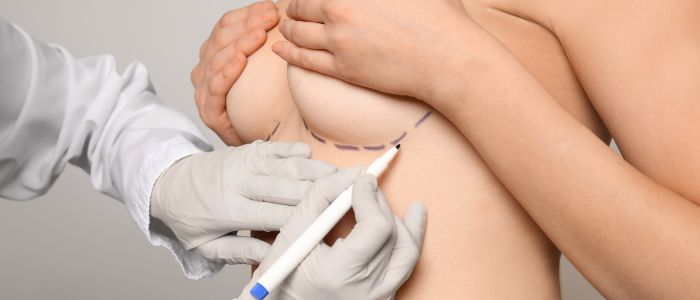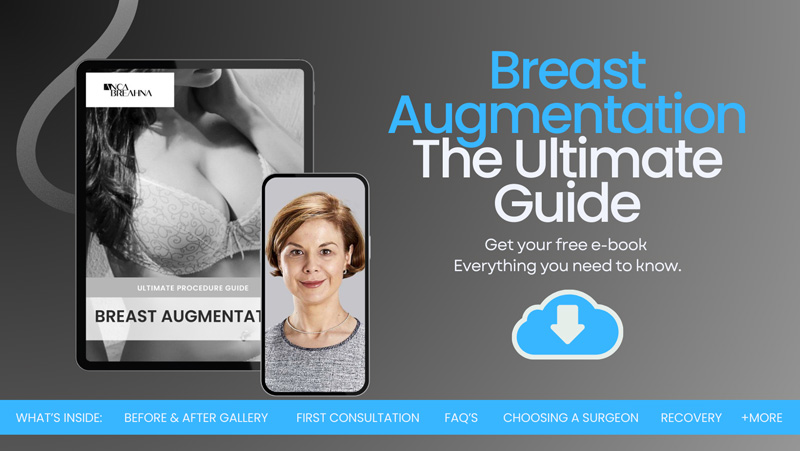
What You Need to Know about Breast Implant Incisions
When it comes to breast augmentation, one of the decisions you’ll need to make is the location of the incision for your implants. The incision site can have a significant impact on the outcome of your surgery, so it’s important to understand the different options and how they compare.
In this blog, Consultant Plastic Surgeon Anca Breahna will cover the three main types of breast implant incisions – inframammary, periareolar, and transaxillary. She will explain the pros and cons of each approach, as well as provide guidance on how to choose the right one for your needs and desired results.
Take our Plastic Surgery Quiz to find out if you’d be a good candidate for cosmetic surgery.
Inframammary Incision
The inframammary incision is one of the most common and popular approaches for breast implant surgery. This incision is made in the crease beneath the breast, where the breast meets the chest wall.
Advantages of the Inframammary Incision
There are several benefits to choosing an inframammary incision for your breast implants:
- Access and Visibility: The incision location provides Anca with excellent access and visibility to the breast pocket, allowing for precise and controlled implant placement. This can result in a smoother, more natural-looking outcome.
- Scar Placement: The scar from an inframammary incision is typically well-hidden in the natural crease of the breast, making it less noticeable. The scar also tends to heal very well in this area.
- Implant Options: With an inframammary incision, you have the widest range of implant types and styles to choose from. This includes both silicone and saline implants.
- Revision Surgery: If you ever need revision surgery in the future, such as implant removal or replacement, the inframammary incision provides easy access to the existing implant pocket.
Disadvantages of the Inframammary Incision
While the inframammary incision offers many benefits, there are a few potential downsides to consider:
- Visible Scarring: Although the scar is usually well-hidden, some people may still be able to see a slight line or discolouration in the breast crease, especially in certain lighting conditions or when the breast is viewed from certain angles.
- Potential Numbness: There is a small risk of temporary or permanent numbness in the lower part of the breast due to incision placement near sensitive nerve endings.
- Implant Positioning: An inframammary incision may make it slightly more challenging to achieve the ideal implant position, particularly for breasts with a naturally low nipple position.
Periareolar Incision
The periareolar incision is made around the outer edge of the areola (the pigmented area surrounding the nipple). This approach has become increasingly popular in recent years, especially for patients seeking a more discreet scar.
Advantages of the Periareolar Incision
Some of the benefits of the periareolar incision include:
- Discreet Scarring: The scar from a periareolar incision is very well-camouflaged, as it blends in with the natural border of the areola. This makes it one of the least visible options.
- Minimal Sensation Loss: There is a lower risk of permanent numbness with a periareolar incision, as the nerves that provide sensation to the nipple and areola are generally better preserved.
- Nipple Position Control: This incision approach can give Anca greater control over the final positioning of the nipple and areola, which may be advantageous for certain breast shapes and types.
- Suitable for Breast Lift: The periareolar incision is often used in conjunction with a breast uplift procedure, as it provides good access to reshape and reposition the breast.
Disadvantages of the Periareolar Incision
While the periareolar incision has some appealing benefits, there are also a few potential downsides to be aware of:
- Limited Implant Options: Patients choosing this incision may have fewer implant type and size options, as larger implants can be more difficult to insert through the smaller periareolar opening.
- Increased Infection Risk: There is a slightly higher risk of infection with a periareolar incision, as the incision passes through the bacteria-rich area around the nipple.
- Visible Scarring: While the scar is generally well-camouflaged, it can sometimes appear slightly more visible, especially in patients with very fair skin tones.
Transaxillary Incision
The transaxillary incision is made in the natural crease of the armpit, allowing the implants to be inserted without any visible scarring on the breast itself.
Advantages of the Transaxillary Incision
The main benefits of the transaxillary approach include:
- No Scarring on the Breasts: As the incision is made in the armpit, there is no visible scarring on the breast. This can be an appealing option for patients concerned about the appearance of scars.
- Maintained Nipple Sensation: Since the incision is not made near the nipple or areola, the risk of permanent numbness or loss of sensation in this area is very low.
- Flexibility in Implant Choice: Transaxillary incisions generally allow for a range of implant types and sizes to be used.
Disadvantages of the Transaxillary Incision
While the transaxillary incision offers some unique benefits, there are also a few potential drawbacks:
- Surgical Complexity: This approach is generally considered more technically challenging, as it requires precise dissection and manipulation to create the implant pocket correctly.
- Limited Access: The armpit incision can make it more difficult for the surgeon to gain optimal visibility and control during the procedure, which may impact the final breast shape and symmetry.
- Revision Challenges: If you ever need revision surgery in the future, such as implant removal or replacement, another incision will be made to access the existing implant pocket.
Download the Breast Augmentation Guide

Choosing the Right Breast Implant Incision for You
When deciding on the best breast implant incision for your needs, there are several factors to consider:
- Scar Visibility: If minimising visible scarring is a top priority, the periareolar or transaxillary approaches may be preferable. The inframammary incision, while well-hidden, will still leave a scar that may be visible in certain circumstances.
- Implant Options: If you have a strong preference for a specific type or size of implant, the inframammary or transaxillary incisions generally offer the widest selection. The periareolar approach may limit your options to some degree.
- Existing Breast Shape and Anatomy: Depending on the current shape, size, and position of your breasts, one incision type may be better suited than the others to achieve your desired outcome. Anca can help you evaluate this.
- Lifestyle and Personal Preferences: Some people may be more comfortable with the idea of an armpit scar (transaxillary) versus a breast crease scar (inframammary). Your personal comfort level and priorities should factor into the decision.
Ultimately, the “best” breast implant incision is the one that aligns most closely with your individual needs, goals, and preferences. Anca will provide expert guidance and recommendations to help you make the right choice.
Preparing for Your Breast Augmentation Surgery
Regardless of which incision option you choose, there are several important steps you can take to prepare for your breast augmentation surgery and support a smooth recovery:
- Stop smoking at least 4-6 weeks before your procedure, as smoking can significantly impair healing.
- Avoid taking certain medications and supplements that can increase bleeding risk, such as aspirin, ibuprofen, and omega-3s. Anca will provide a detailed list of what to avoid.
- Ensure you have someone lined up to drive you home from the surgery and assist with daily tasks for the first few days of recovery.
- Stock up on comfortable, loose-fitting clothing that will be easy to get in and out of, such as button-down shirts.
- Prepare your home environment by setting up a comfortable recovery space with pillows, ice packs, and anything else you might need close at hand.
- Stay hydrated, eat a nutritious diet, and get adequate rest in the weeks leading up to your surgery.
By taking these proactive steps, you can help set yourself up for the best possible surgical experience and outcome.
FAQs about Breast Implant Incisions
What are the other common incision options for breast implants besides the inframammary incision?
- The other commonly used incision options for breast implants include the periareolar incision and the transaxillary incision. The periareolar incision is made around the outer edge of the areola (the darkened skin surrounding the nipple). The transaxillary incision is made in the natural crease of the armpit. Each of these incision locations offers its own unique advantages and considerations for the patient and surgeon to evaluate.
How does the recovery and scarring differ between the various incision types?
- Recovery time and scar appearance can vary depending on the incision location. For example, periareolar incisions may have slightly more noticeable scarring around the areola, as the incision is made in a relatively visible area of the breast. Transaxillary incisions may involve a longer recovery time due to the incision being further from the breasts and potentially impacting shoulder mobility during the healing process. In contrast, inframammary incisions tend to heal well and leave scars that are well-hidden in the natural breast crease. The visibility and appearance of scars can also depend on factors like skin type, healing, and surgical technique.
What factors does Anca consider when recommending a specific incision type?
- Anca will take into account a variety of factors when determining the most appropriate incision location for your breast implant surgery. This includes your anatomy, breast characteristics (e.g. ptosis, asymmetry), desired implant type and size, and personal preferences regarding scar visibility. Anca’s goal is to recommend the incision that will achieve the best possible aesthetic outcome with minimal visible scarring, while also considering factors like surgical access and implant positioning. She will discuss the pros and cons of each option to help you make an informed decision.
Can the incision type be changed if the patient is unhappy with the resulting scarring?
- In some cases, yes, it may be possible to undergo a secondary procedure to revise the scar or switch to a different incision type if the patient is unsatisfied with the appearance of the initial incision scar. However, this would require additional recovery time and cost. Factors like the quality of the existing scar, the patient’s skin type and healing process, and Anca’s assessment of the feasibility of the revision would all need to be considered.
Are there any differences in the surgical technique or implant placement between the incision options?
- Yes, the specific surgical approach and precise implant positioning can vary slightly depending on the incision location. The incision location can impact factors like visibility, accessibility, and the ability to achieve the ideal implant placement and symmetry.
Further Reading about Breast Implants Surgery with Consultant Plastic Surgeon Anca Breahna
- Read more about How to Choose the Best Breast Implant Profile and Projection
- Read more about How to Get a Natural Looking Breast Augmentation Using Smaller Implants
- Read more about Breast Augmentation with Mentor Breast Implants
- Read more about Benefits of Motiva Breast Implants
- Read more about Types of Breast Implants
- Read more about Signs It’s Time to Replace Your Breast Implants
- Read more about How to Perform a Breast Implant Check
Medical References about Breast Implant Incisions – Inframammary, Periareolar, Transaxiliary
- Minimal inframammary incision for breast augmentation – NCBI
- Incision and Capsular Contracture Risk – NCBI
- Effect of Incision Choice on Outcomes in Primary Breast Augmentation – Oxford Academic
- Breast Implants – Cleaveland Clinic
- The Inframammary Approach to Breast Augmentation -Science Direct

 Ms Anca Breahna, PhD, MSc, FEBOPRAS, FRCS (Plast) is a highly regarded Consultant Plastic Surgeon specialising in the field of Aesthetic and Reconstructive Plastic Surgery. Anca performs a range of
Ms Anca Breahna, PhD, MSc, FEBOPRAS, FRCS (Plast) is a highly regarded Consultant Plastic Surgeon specialising in the field of Aesthetic and Reconstructive Plastic Surgery. Anca performs a range of 